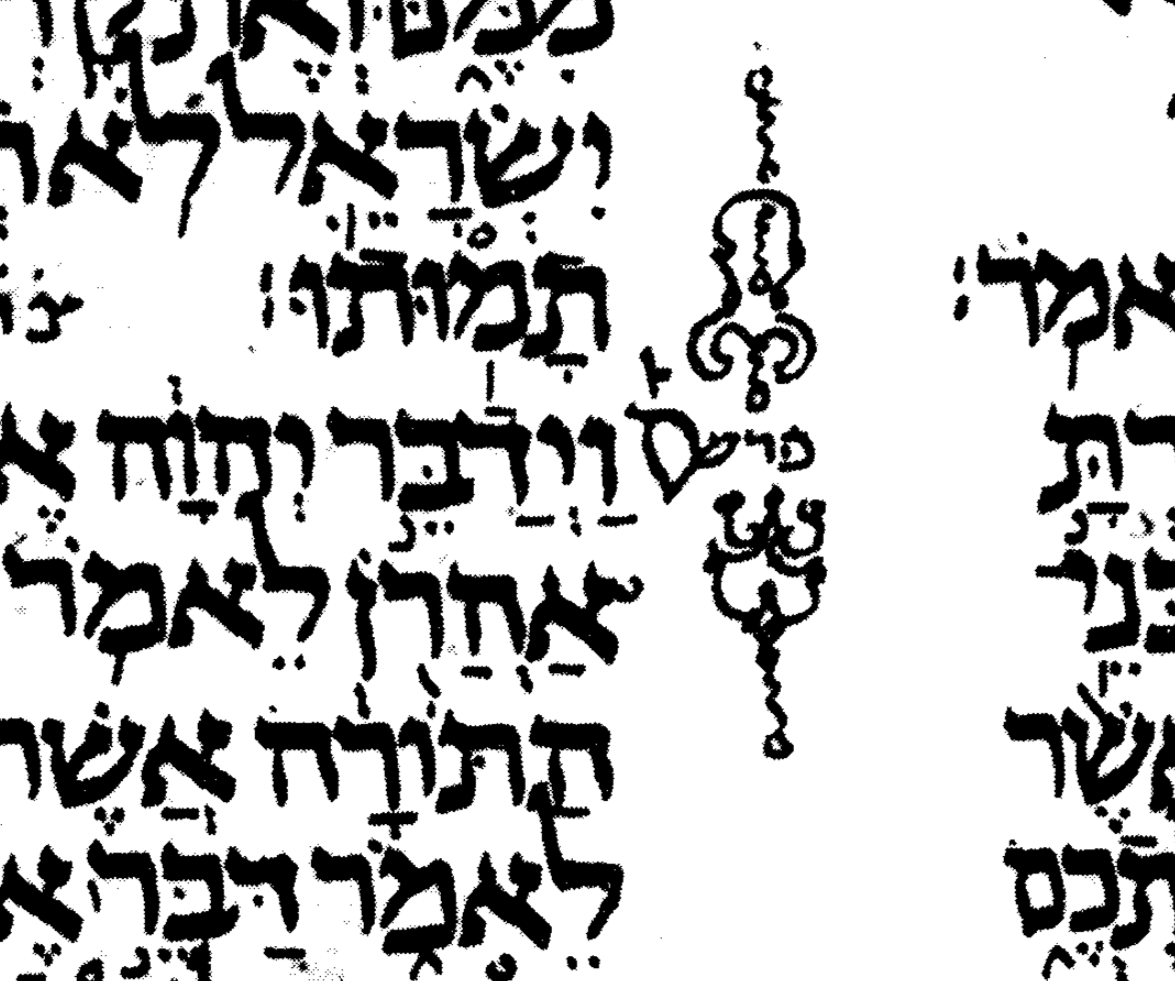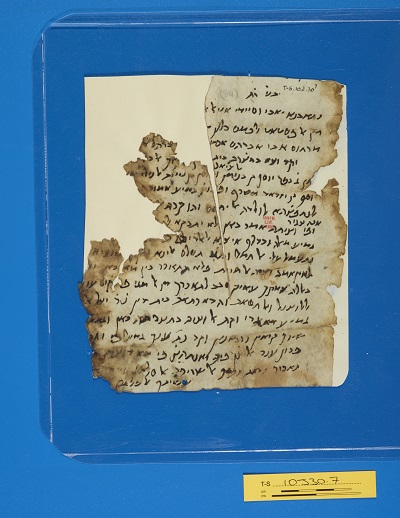The first owners of the Leningrad Codex: T-S 10J30.7
In my previous Fragment of the Month on Codex Leningrad (St Petersburg, National Library of Russia, Firkovich MS. Hebrew I, B19a – or Евр. I B 19a), I showed how documentary sources from the Cairo Genizah can help to fill out the picture of its manufacture: illuminating our knowledge of its scribe and of the social and cultural background to this great codex’s production. I also showed that the book itself, notably the colophons, preserves important historical material. Indeed, much information can be derived from the plain colophon (f. 1r), which is, in its own right, a superb example of the art of the Medieval Hebrew biblical colophon, replete with linguistic playfulness, copious biblical allusion and artful obscurity. As with the copying and production of the codex, the scribe Samuel b. Jacob has excelled himself. Thanks to this colophon, we know where, when and by whom Евр. I B 19a was written (with a slight uncertainty as to the exact date of completion), as well as who owned it over several centuries.
The question of ownership is a significant one, since it speaks to the wider context of the book’s intended use and potential audience, an aspect of the research on the biblical text which is often overlooked. Within which tradition or for which Jewish confessional congregation was this Bible produced? This is the sort of information that is not usually explicitly stated in colophons, but must be gleaned from our knowledge of the people involved, again relying on the Genizah documentary manuscripts to fill out the picture. Medieval Fusṭāṭ, like Egypt at large, was home to Babylonian (that is Iraqi) and Jerusalemite (that is Palestinian) rabbanite congregations, as well as a powerful Karaite community, which tended to form around family groups or clans. Was Евр. I B 19a in origin a Karaite codex, written by or for a Karaite? The place accorded to the Bible in Karaite tradition certainly suggests that they might be at least partially responsible for the copious production of impressive codices like Codex Leningrad in the tenth and eleventh centuries, not to mention the Karaites’ potential role in the masoretic activity in Tiberias. The Karaites were a major social, economic and political force in Egypt and a considerable intellectual force in Palestine, and this role enabled, and probably required, them to commission works of this quality and value.
According to the colophon, Samuel b. Jacob copied the text of Евр. I B 19a for Mevoraḵ b. Joseph b. Netanʾel known as Ibn Yazdād ha-Kohen, מבורך בן יוסף בן נתנאל הידוע בן יזדאד הכהן (f. 1r lines 6–7). Samuel glorifies Mevoraḵ’s name in gold and micrography in several of the splendid carpet pages that adorn the book (e.g., ff. 474r, 475v and 478v, among others), so there can be no doubt that he was the original commissioner of the work, Samuel’s paymaster.#1 Mevoraḵ’s family name is of Persian origin – Yazdād means ‘God has given’, ie ‘God’s gift’ – and an Ibn Yazdād, probably Mevoraḵ’s father, appears in commercial correspondence from the Genizah early in the eleventh century, whence it seems he is based in Egypt and plays a role in Mediterranean trade (Goitein, 1973: 31). Mevoraḵ himself clearly possessed significant social status, and probably also personal wealth, as we find that he was appointed around 1019 CE to oversee the two supervisors of an inheritance, ensuring the safeguarding of a substantial sum in trade goods for the minor son of a merchant called Samuel ha-Levi b. Abraham. This case is well documented in the Genizah, through letters and legal deeds, as it eventually required litigation in both the Muslim and Jewish courts when the orphan was declared of age and sought aggressively to assert his rights (Bareket 1998:124–136; Goitein 1978: 293–295). Mevoraḵ seems to have been a diligent overseer of the inheritance, and we can see some of his correspondence in the matter in T-S 10J30.7, a letter that he wrote to one of the deceased merchant’s business partners.
A letter by the original owner of Codex Leningrad, Mevoraḵ b. Joseph (T-S 10J30.7)
Another piece of correspondence in the case, T-S 16.27, written by the supervisors themselves, reveals Mevoraḵ’s name in Arabic, Abū l-Ḥusayn al-Mubarak ibn Yūsuf ibn Yazdād. Goitein believes that Mevoraḵ is a Karaite, and it seems that the supervisors and overseer were deliberately chosen to encompass the range of Jewish congregations in Fustat — Rabbanites and Karaites, Babylonians and Palestinians. Bareket, who also studied the case, suggests that there is not enough evidence to be sure (Bareket 1998: 125 n. 8). However, she is not aware of T-S 16.171, a Karaite legal deed from 1004 CE, that shows that Mevoraḵ’s father, Joseph ibn Yazdād, also enjoyed a position of trust – in Karaite society. The deed names him as one of three supervisors of a Persian Karaite merchant’s worldly possessions. This is all strong circumstantial evidence that the Ibn Yazdād family were themselves Persian Karaites, and chimes with Samuel b. Jacob’s use of a distinctively Karaite system of dating, alongside all the others, in the main colophon (according to the Exile of King Jehoiachin, f. 1r line 3).
Mevoraḵ was not the only Karaite to own the codex. The last few lines of the plain colophon were added over a hundred years after its manufacture and reveal that in 1135 CE the book was sold to the leading rabbanite Maṣliaḥ ha-Kohen, Gaʾon of the Palestinian Yeshiva, an ownership fact asserted in attractive Medieval Hebrew legalese and witnessed by Ḥalfon ha-Levi b. Manasseh (one of the most prolific court scribes of the Genizah, widely attested in twelfth-century documents), Manasseh ha-Kohen b. Jacob and the well-named Levi ha-Levi b. Yefet ha-Levi. Maṣliaḥ did not purchase Евр. I B 19a from Mevoraḵ’s family, however, but from another owner, identified as המשכיל … יוסף הנודע בן כוגׄך, ‘the sage… Joseph known as Ibn Kujik’. Kuchek, ‘small’, is another Persian family name (کوچک in Persian), and maskil, ‘sage’ or ‘teacher’, is a Karaite title in this period. The Kuchek family is furthermore explicitly identified as Karaite in a thirteenth-century letter from Judge Elijah, when he refers to אלשיך אלתקה אלקרא בן כושך, ‘the faithful sheikh, the Karaite, Ibn Kushek’ (T-S 13J18.7).
So, Codex Leningrad was produced for, most likely, a Persian Karaite, and was subsequently acquired by a Persian Karaite, who sold it to Maṣliaḥ ha-Kohen b. Solomon, Gaʾon (head) of the Jerusalem Yeshiva. Maṣliaḥ was the highest intellectual authority in Palestinian Judaism and ‘Head of the Jews’ (Raʾīs al-Yahūd) in the Fatimid Empire. That such a powerful and senior figure should acquire the Bible strongly attests to the value ascribed to it in its day (today’s critics of Samuel b. Jacob’s work should take note). In addition, evidently its Karaite provenance did not devalue it in Maṣliaḥ’s eyes and deter him from purchasing it.
Of course, if you are not particularly interested in the context of this Bible’s production or the book-history of the eastern Jewish community, then perhaps you might wonder what value there is in delving into the documentary record in this way. Well, you could consider that owners often leave their mark on a book beyond the simple addition of their name to the title page or the occasional manicule, and that a medieval codex, therefore, is more than just the product of its original creator’s ambition. The form in which we have Евр. I B 19a today is a result of Mevoraḵ b. Joseph ibn Yazdād’s specifications when he commissioned it, moderated through Samuel b. Jacob’s considerable scribal ability and artistic ambition. It demonstrates his desire to have a valuable, prestigious copy of the Bible to show off his wealth, his status and his piety. Subsequent owners would have been proud to have such a beautiful and correct copy of the Bible, as Maṣliaḥ’s acquisition of it shows, but it may not have perfectly suited their requirements. The Karaites, having their origins in the Jewish east, followed the Babylonian reading tradition, the annual reading cycle of the Torah. Codex Leningrad possesses the customary parasha headings denoting this cycle, decorated in a manner familiar to those used to looking at medieval biblical codices. Samuel b. Jacob has done his work well here. But when you look at the seder markers, the (usually numbered) sameḵs in the margins that denote the Palestinian triennial reading tradition (and which continue throughout the whole Tanach, denoting study divisions of some sort), it is clear that they are in many cases secondary. They are often ill-planned, later additions to the primary layout of the pages, the columns and the masora, and these are probably not in Samuel’s handwriting. When they coincide with a parasha marker, they are either squished in alongside it, or relegated to the opposite side of the column. Occasionally they are even written over the top of masoretic notes.

Poor seder marker placement on folio 87r of Евр. I B 19a cannot be the work of the original scribe (image from the Loewinger facsimile edition, Wikimedia Commons)
Notes
1. Although Samuel spells Ibn Yazdād's name יזדאד on most occasions, he does write it once אזדאד, f. 474r. While this might represent the general predilection for variety among medieval Jewish writers, it's unlikely, given it's spelled correctly everywhere else: it's an unfortunate error by Samuel, arising from the unusual foreign name. Hopefully nobody was crass enough to point it out to Mevoraḵ when he first proudly unveiled his book.
2. Such as Samuel b. Jacob's use of a tongue-twisting three successive shewas in his spelling of 'the Jerachmeelite' הירחמאלי in 1 Samuel 27:10 and 1 Samuel 30:29. This feature, unique to his biblical manuscripts, has been corrected in 1 Samuel 30:29, but left uncorrected in 1 Samuel 27:10. It is preserved in the other manuscripts he is known to have copied (Phillips 2017: 16).
Bibliography
Bareket, E. (1998). פרשת אברהם בן שמואל הספרדי על שמונה מסמכים מן הגניזה, in E. Fleischer, M. A. Friedman and J. A. Kraemer (eds), Mas’at Moshe: studies in Jewish and Islamic Culture presented to Moshe Gil, 124–136.
Goitein, S. D. (1967–1993). A Mediterranean Society: the Jewish communities of the Arab world as portrayed in the documents of the Cairo Geniza. 5 volumes with an index volume by P. Sanders.
Phillips, K. (2017). ‘A New Codex from the scribe behind the Leningrad Codex: L17’, Tyndale Bulletin 68.1, 1–29.
Cite this article
The first owners of the Leningrad Codex: T-S 10J30.7. [Genizah Research Unit, Fragment of the Month, November 2017]. https://doi.org/10.17863/CAM.28071
If you enjoyed this Fragment of the Month, you can find others here.
Contact us: genizah@lib.cam.ac.uk
The zoomable images are produced using Cloud Zoom, a jQueryimage zoom plugin:
Cloud Zoom, Copyright (c) 2010, R Cecco, www.professorcloud.com
Licensed under the MIT License

